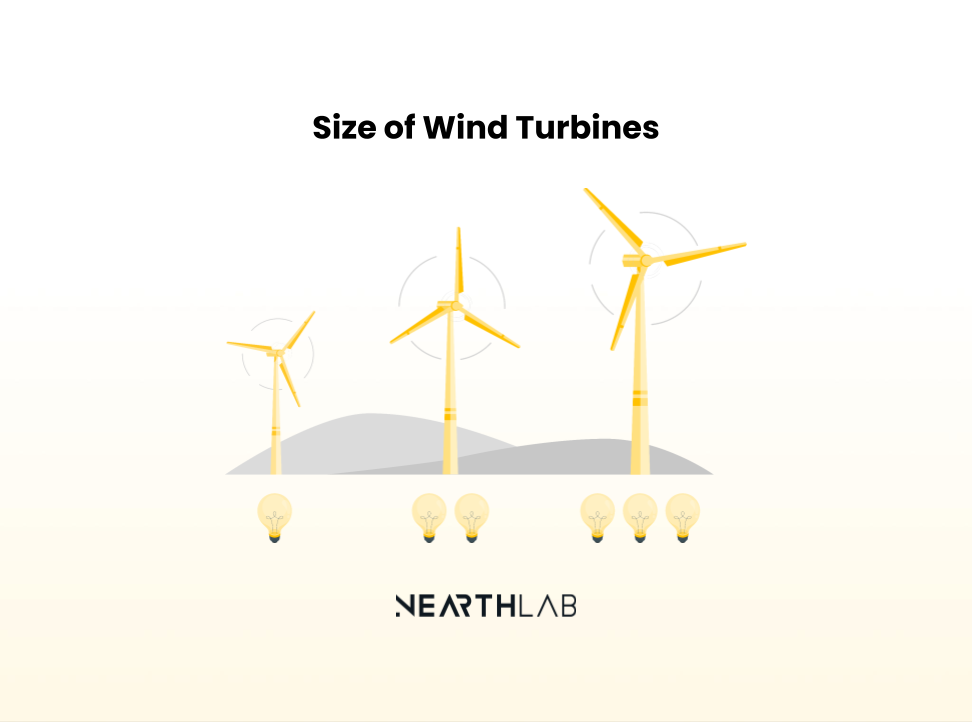Turbine Inspections
Wind Turbine Sizes

Progress in the renewable energy sector is often measured in leaps and bounds, and the wind industry is no exception.
In recent years, there has been a monumental shift toward embracing the era of supersized wind turbines.
But why go big? Isn’t bigger synonymous with more expensive?
Let’s unravel the mysteries behind the meteoric rise of these colossal structures and explore why bigger might just be better.
Why Go Big?
The logic behind building ever-larger wind turbines is rather straightforward.
Larger blades mean more wind capture, resulting in a substantial increase in electricity generation.
Consider these numbers: while typical onshore turbines with an average rotor diameter of 430 feet produce around 1.5 MW, GE Haliade X, with an impressive 722 feet rotor (nearly double the height of the tower Big Ben sits on), can produce a staggering 15 MW.
Putting up a handful of larger turbines has also proven to be much more efficient than flooding the landscape with smaller ones. Doing so not only saves space but also marks down material usage and maintenance costs, leading to higher returns on investment.
Scaling New Heights
The question then arises: how do you elevate these turbines to such heights?
- Expanding the Rotor Blades. By scaling up blade size, turbines can cast a wider net, capturing more wind energy across a vast area.
- Elevating to Higher Altitudes. By hoisting the rotors to greater heights with the help of taller towers, where the wind blows consistently and with more force, wind turbine blades can operate at peak performance.
The Grand Challenge
While bigger the better certainly seems to be the mantra in wind turbine design, engineering taller turbines with expansive blades is no easy feat.
Beyond technical challenges, there are non-technical limitations such as bottlenecks in transportation, infrastructure concerns, worries over land use, obstructed views, and potential impacts on avian life.
The very scale that makes these turbines formidable also brings its own set of challenges.
Solution: Offshore Wind Turbines
The solution to these challenges comes in the form of offshore wind turbines.
The boundless expanse of the ocean provides an opportunity to overcome constraints inherent in land-based alternatives. A prime example of this is GE Renewable Energy’s commitment of $400 million to develop the Haliade-X.
Standing as the largest, tallest, and most potent commercially available wind turbine to date, Haliade-X charts new frontiers in both efficiency and sustainability.
How High Can It Go?
In theory, the sky is the limit when it comes to the height of wind turbines. However, reality interjects with its own set of challenges that demand careful consideration.
Balancing Act
A looming concern is the erosion of turbine blades. Engaged in constant battle against raindrops and sea spray, the speed of the blade tips must be capped at 200 mph to thwart accelerated erosion. This limitation means that, as turbines grow larger and blades extend further, their rotors must spin at a slower rate to prevent wear and tear.
The Domino Effect
Slowing down the rotor to counteract high wind speeds triggers a domino effect. To maintain power output, the blades must deflect the wind to a greater extent, placing additional strain on other wind turbine components.
While expanding the surface swept by the rotor could be a potential solution, it brings its own challenges. Larger designs become progressively heavier, and the increasing blade length leads to higher manufacturing costs. At a certain point, the extra cost starts to outweigh the additional electricity generated.
Longer blades introduce yet another challenge — an increased susceptibility to bending. This complicates the task of maintaining complete control over the aerodynamics of wind flow and ensuring that the blades do not collide with the turbine tower, particularly under extreme weather conditions.
Technological breakthroughs may eventually overcome these engineering challenges. Yet, logistics present an entirely different narrative. The transportation and assembly of these large turbines pose logistical hurdles that must be addressed. Specifically, shipping Big Ben-sized blades in one piece demands vast ports, giant vessels, and offshore cranes capable of safe and reliable operation.
Nurturing the Future of Wind Power
As turbines reach unprecedented heights, an uncomfortable truth rises to the surface — no matter their towering stature or prolific output, the true potential of a turbine remains untapped if not meticulously maintained.
Regular, detailed inspections are the linchpin of a robust Operations and Maintenance (O&M) strategy, ensuring these colossal structures fulfill their maximal lifespan, consistently churning out cost-effective electricity.
In facing the challenge of these soaring giants, autonomous drone inspections have become an indispensable protocol in the maintenance playbook. But the story doesn’t end there.
To handle the vast amounts of data generated during inspections, intelligent analytics capabilities are imperative. Relying on antiquated methods to manage the expanding fleets is simply unsustainable.
Enter Nearthlab, a pioneering force offering a comprehensive suite of solutions designed to streamline the entire O&M process.
From NearthWIND Pro and Mobile, seamlessly conducting autonomous blade inspections even in the harshest offshore conditions within 15 minutes, to our cutting-edge analytics platform, Zoomable. The platform not only processes and identifies defects with pinpoint accuracy but compiles them into meticulously crafted reports at a moment’s notice.
Eager to explore ways to effortlessly manage your fleets? Click the button below and let us demonstrate how Nearthlab can propel your endeavors to new heights.
